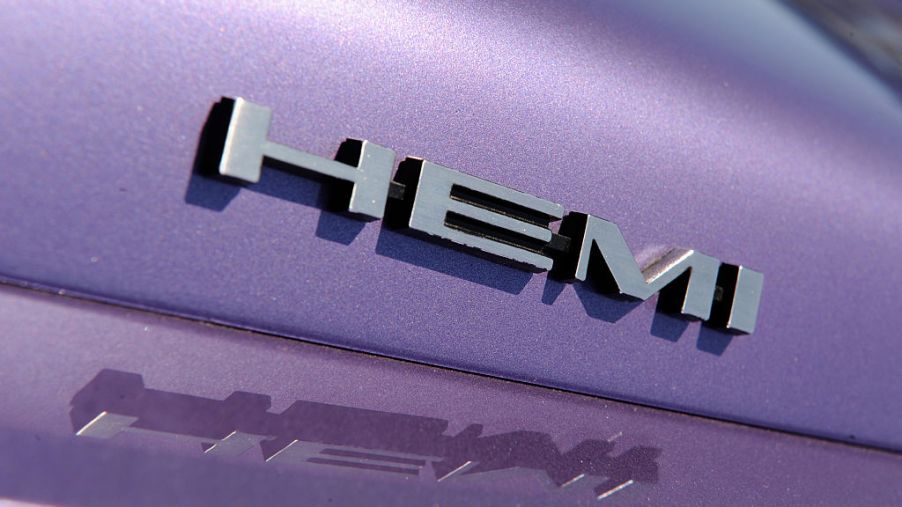
The Dependable History of the HEMI Engine
The HEMI engine is the stuff of legend. From the 1950s to the ’70s, Chrysler’s HEMI engines dominated the automotive industry. Today, muscle cars such as the Dodge Challenger and its sibling, the beast-of-the drag-strip Dodge Demon are equipped with HEMIs. These engines also power Ram pickups, including the massive heavy-duty Ram 2500 Power Wagon.
An engine that’s been called into action for more than six decades must have a lot going for it. What’s the secret behind the HEMI’s longevity? And why, after all these years, even people who aren’t car lovers are intrigued by the mystique that surrounds the HEMI? Let’s do some sleuthing to find the answers to these questions.
History of the HEMI
The core of the HEMI was an efficient hemispherical combustion chamber with domed cylinder heads. The basic design was used in car engines as far back as 1901, and most had only four cylinders. Then, in 1948, Harry Westlake along with six others broke through with a six-cylinder engine for Jaguar that used the basic HEMI technology.
But Chrysler brought the design to prominence in 1950 for the 1951 Saratoga, New Yorker, and Imperial models. A few years before, the manufacturer had already used this design to build a 2,500-hp V16 engine for an experimental version of the Republic P-47 fighter plane.
Chrysler was able to leverage its experience in building this engine to create the first HEMI V8 that had a displacement of 331 cubic inches and delivered 180 hp.
This amount of power was groundbreaking for a car in the early 1950s. By comparison, competitors such as the Buick Roadmaster and the Oldsmobile 88 produced at least 40 hp less and also had significantly lower displacement.
Over the next several years, Chrysler continued to build HEMI engines with ever-increasing displacement, jumping from 331 cubic inches to 354 in 1956 and to 392 in 1957.
In 1964, the automaker introduced the second-generation 426-cubic-inch HEMI engine that made its mark by taking first, second, and third place in the Daytona 500.
The following year, Chrysler offered a street-legal HEMI that cranked out 425 hp, nicknamed “the elephant engine” due to its size, weight, and sheer power. Special production cars built for drag racing were equipped with the 426. These included the Plymouth Fury, the Plymouth Barracuda, and the Dodge Dart, which were only in production until the mid-’70s at best.
The combeback
After a hiatus of more than 30 years, Chrysler released the current third-generation HEMI engine in 2003. The original version was a 5.7-liter V8 with 345 cubic inches of displacement and is the same engine used today in Ram pickups. A mid-2000s variant was the 6.1, which was used in SRT-8 versions of the Chrysler 300C, the Jeep Cherokee, the Dodge Magnum, Charger and Challenger.
In 2015 Chrysler produced the 6.2 Hellcat, used in current models of the Dodge Charger SRT Hellcat, Dodge Challenger SRT Hellcat, and the Jeep Cherokee SRT Trackhawk. The Demon 6.2 was introduced three years later for the Dodge Challenger SRT Demon. Both the Hellcat and the Demon HEMI variants are supercharged for high performance.
Two reasons why the HEMI churns out the power
From a functional standpoint, the HEMI engine has a couple of important advantages over other engines. The engine’s cylinder heads are shaped like a half-sphere. As compared to the old flathead engines made before the 1950s, this hemispherical shape of the heads takes up less surface area.
Having less surface area means that less heat is lost, so the fuel near the walls of the heads doesn’t cool as quickly. As a result, more heat in the cylinders creates more pressure to push down the piston and develop more power for the engine.
On a HEMI engine, the spark plug is located at the top of the combustion chamber and the valves open on opposite sides of it. Because the valves are positioned this way, they can be bigger than those in an inline engine configuration.
In this case, bigger valves are better because they increase airflow through the cylinders to improve the air-fuel mix and thus increase performance. And while other contemporary engines may have an edge over the HEMI thanks to smaller combustion chambers and other efficiencies, the HEMI had set a high standard for power.
Will it ever lose its charm?
But the appeal of the HEMI reaches beyond its technical advantages. Fans of muscle cars past and present continue to hold it in high regard. The brawn of the 426 HEMI in NASCAR racing was translated into “street HEMI” production cars that gave chase to the era’s pony cars. It also provided the basis for the engine variant that evolved into the one used in NHRA and AHRA drag racing today.
Finally, the rising popularity of Ram pickup trucks keeps the HEMI in the public eye. This year, the Ram 1500 has pushed aside the Chevrolet Silverado to rank second among the best-selling full-size trucks.
The Ram’s 5.7-liter HEMI V8 provides produces 395 hp and as much as 510 lb-ft of torque. Its tow rating maxes out at 12,750 pounds, which stands as another testament to the HEMI’s strength and durability.
While the HEMI may be surpassed by more efficient and even more robust engines these days, there’s no question that it’s made a powerful impact on engine technology and car culture over the past 70 years.
We hope that the HEMI can provide the power and torque for some of our favorite cars and trucks for another six decades.


